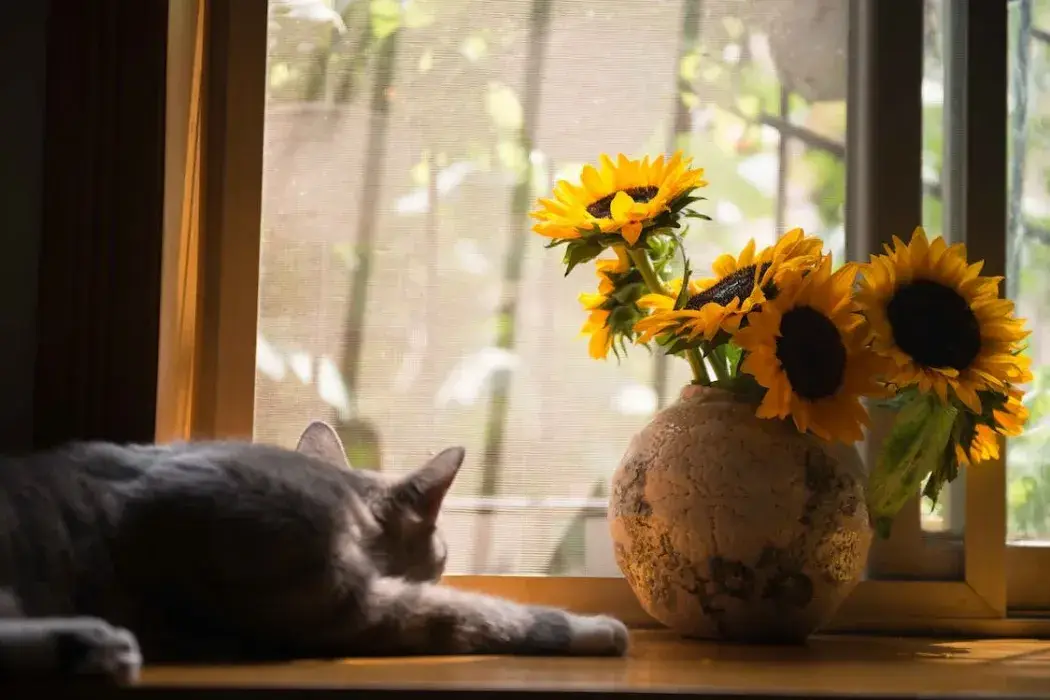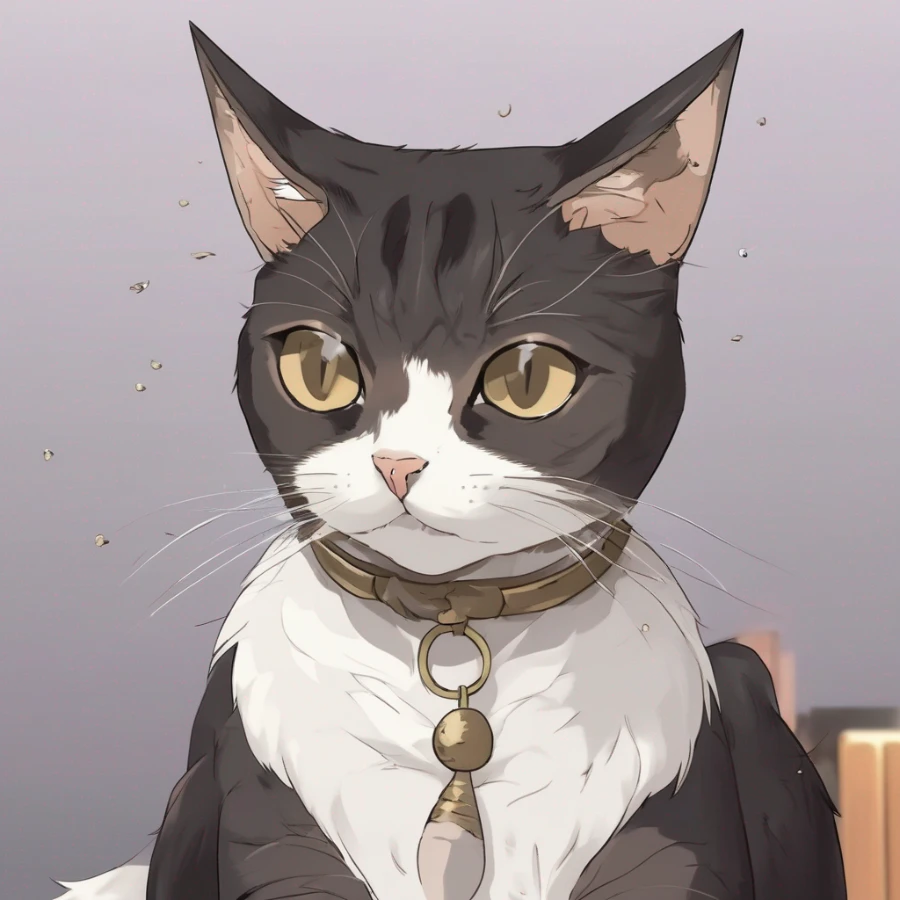Cat Stung by a Bee: Main Tips What to Do

Published by: Tatsiana Korshik
Time to Read: 4 Min

If your cat has been stung by a bee, it's important to take action promptly to ensure their safety and comfort. Here are the main steps you should consider:
Stay Calm: Your cat might be in pain or discomfort, but it's important for you to remain calm. Your cat can pick up on your emotions, so your composed demeanor will help keep them at ease.
Assess the Situation: If you witnessed the sting, take note of where the sting occurred and how your cat is reacting. Look for signs of an allergic reaction, such as excessive swelling, difficulty breathing, or hives. These symptoms could be serious and might require immediate veterinary attention.
Remove the Stinger: If you can see the stinger, carefully remove it. Use a credit card or your fingernail to scrape it off the skin. Avoid using tweezers, as they might squeeze more venom into the wound.
Clean the Area: Gently clean the area with mild soap and water to prevent infection. Pat the area dry with a clean, soft towel.
Monitor for Allergic Reactions: Keep a close eye on your cat for the next few hours. If you notice signs of an allergic reaction—such as severe swelling, difficulty breathing, vomiting, or lethargy—seek immediate veterinary assistance.
Apply a Cold Compress: If the area is swollen or painful, you can apply a cold compress wrapped in a thin cloth to the sting site for about 10 minutes at a time. This can help reduce pain and swelling.
Offer Pain Relief: If your cat is in discomfort, consult your veterinarian before giving any over-the-counter pain relievers. Some medications that are safe for humans can be toxic to cats.
Keep Your Cat Indoors: While your cat might be curious about the outdoors, it's best to keep them indoors for the next few days to avoid further encounters with bees or other potential hazards.
Veterinary Consultation: If your cat's condition worsens, if there are signs of an allergic reaction, or if the sting site becomes infected, consult your veterinarian. They can provide appropriate guidance and treatment.
Remember, every cat's reaction to a bee sting can be different. If you're ever unsure or concerned about your cat's well-being, it's always best to seek professional veterinary advice.
Assess the Situation: Observe your cat closely. If you notice any signs of distress, drooling, or difficulty breathing, it's a serious situation that requires immediate veterinary attention.
Gently Examine the Mouth: If your cat allows, take a look inside their mouth. Be cautious, as your cat might be in pain. If you can see the bee's stinger, try to carefully remove it using a credit card or your fingernail. Do not use tweezers, as they could push the stinger deeper.
Administer Cold Compresses: If you notice any swelling, you can apply a cold compress wrapped in a thin cloth to the outside of the mouth or the affected area of the face. This can help reduce pain and swelling.
Monitor Breathing: Keep a close watch on your cat's breathing. If you notice any signs of breathing difficulty—such as open-mouth breathing, wheezing, or gasping for air—seek immediate veterinary care.
Offer Water: If your cat is willing to drink, provide them with fresh water. This can help soothe the mouth and throat.
Watch for Allergic Reactions: Keep an eye out for any signs of an allergic reaction, including excessive swelling, hives, vomiting, or lethargy. These symptoms require immediate veterinary attention.
Seek Veterinary Care: Even if your cat's symptoms seem mild, it's advisable to consult your veterinarian. Stings in the mouth can lead to swelling that might not be immediately apparent but could become problematic.
Remember, bee stings can cause serious reactions, especially if the sting is in the mouth or if your cat is allergic. It's always better to err on the side of caution and seek professional veterinary care if you have any concerns about your cat's well-being. Your veterinarian can provide appropriate treatment and advice based on your cat's specific situation.
Check for the Stinger: Carefully examine your cat's paw to see if the bee's stinger is still embedded. If you can see the stinger, gently remove it using a credit card or your fingernail. Avoid using tweezers, as they might push the stinger deeper.
Clean the Area: If your cat allows, clean the area with mild soap and water to prevent infection. Gently pat the paw dry with a clean, soft towel.
Apply a Cold Compress: To reduce pain and swelling, you can apply a cold compress wrapped in a thin cloth to the affected paw. Apply it for about 10 minutes at a time, with breaks in between.
Observe for Swelling and Discomfort: Keep an eye on your cat's paw for any signs of excessive swelling, redness, or discomfort. Some swelling is normal, but if it seems severe or your cat appears to be in significant pain, consult your veterinarian.
Monitor for Allergic Reactions: Watch for signs of an allergic reaction, such as difficulty breathing, hives, vomiting, or lethargy. If you notice any of these symptoms, seek immediate veterinary attention.
Pain Relief: If your cat seems to be in discomfort, consult your veterinarian before giving any over-the-counter pain relievers. Some medications that are safe for humans can be toxic to cats.
Keep an Eye on Behavior: While some cats might only experience mild discomfort after a bee sting, others might be more affected. Monitor your cat's behavior for any changes and seek veterinary care if you're concerned.
Prevent Further Exposure: After a bee sting, it's a good idea to keep your cat indoors for a while to minimize the risk of further stings.
Veterinary Consultation: If you're unsure about the severity of the reaction or if your cat's condition worsens, consult your veterinarian. They can provide guidance and determine if any additional treatment is necessary.
Remember that reactions to bee stings can vary widely among cats. If you're ever concerned about your cat's well-being, it's best to seek advice from a veterinarian who can provide personalized recommendations based on your cat's specific situation.
Stay Calm: Your cat might be in pain or discomfort, but it's important for you to remain calm. Your cat can pick up on your emotions, so your composed demeanor will help keep them at ease.
Assess the Situation: If you witnessed the sting, take note of where the sting occurred and how your cat is reacting. Look for signs of an allergic reaction, such as excessive swelling, difficulty breathing, or hives. These symptoms could be serious and might require immediate veterinary attention.
Remove the Stinger: If you can see the stinger, carefully remove it. Use a credit card or your fingernail to scrape it off the skin. Avoid using tweezers, as they might squeeze more venom into the wound.
Clean the Area: Gently clean the area with mild soap and water to prevent infection. Pat the area dry with a clean, soft towel.
Monitor for Allergic Reactions: Keep a close eye on your cat for the next few hours. If you notice signs of an allergic reaction—such as severe swelling, difficulty breathing, vomiting, or lethargy—seek immediate veterinary assistance.
Apply a Cold Compress: If the area is swollen or painful, you can apply a cold compress wrapped in a thin cloth to the sting site for about 10 minutes at a time. This can help reduce pain and swelling.
Offer Pain Relief: If your cat is in discomfort, consult your veterinarian before giving any over-the-counter pain relievers. Some medications that are safe for humans can be toxic to cats.
Keep Your Cat Indoors: While your cat might be curious about the outdoors, it's best to keep them indoors for the next few days to avoid further encounters with bees or other potential hazards.
Veterinary Consultation: If your cat's condition worsens, if there are signs of an allergic reaction, or if the sting site becomes infected, consult your veterinarian. They can provide appropriate guidance and treatment.
Remember, every cat's reaction to a bee sting can be different. If you're ever unsure or concerned about your cat's well-being, it's always best to seek professional veterinary advice.
Cat Stung by Bee in Mouth
If your cat has been stung by a bee in the mouth, it's crucial to act quickly and carefully. Stings in the mouth can be more problematic due to potential swelling and obstruction of the airway. Here's what you should do:Assess the Situation: Observe your cat closely. If you notice any signs of distress, drooling, or difficulty breathing, it's a serious situation that requires immediate veterinary attention.
Gently Examine the Mouth: If your cat allows, take a look inside their mouth. Be cautious, as your cat might be in pain. If you can see the bee's stinger, try to carefully remove it using a credit card or your fingernail. Do not use tweezers, as they could push the stinger deeper.
Administer Cold Compresses: If you notice any swelling, you can apply a cold compress wrapped in a thin cloth to the outside of the mouth or the affected area of the face. This can help reduce pain and swelling.
Monitor Breathing: Keep a close watch on your cat's breathing. If you notice any signs of breathing difficulty—such as open-mouth breathing, wheezing, or gasping for air—seek immediate veterinary care.
Offer Water: If your cat is willing to drink, provide them with fresh water. This can help soothe the mouth and throat.
Watch for Allergic Reactions: Keep an eye out for any signs of an allergic reaction, including excessive swelling, hives, vomiting, or lethargy. These symptoms require immediate veterinary attention.
Seek Veterinary Care: Even if your cat's symptoms seem mild, it's advisable to consult your veterinarian. Stings in the mouth can lead to swelling that might not be immediately apparent but could become problematic.
Remember, bee stings can cause serious reactions, especially if the sting is in the mouth or if your cat is allergic. It's always better to err on the side of caution and seek professional veterinary care if you have any concerns about your cat's well-being. Your veterinarian can provide appropriate treatment and advice based on your cat's specific situation.
Cat Paw Stung by Bee
If your cat's paw has been stung by a bee, you'll want to take steps to provide relief and monitor for any adverse reactions. Here's what you can do:Check for the Stinger: Carefully examine your cat's paw to see if the bee's stinger is still embedded. If you can see the stinger, gently remove it using a credit card or your fingernail. Avoid using tweezers, as they might push the stinger deeper.
Clean the Area: If your cat allows, clean the area with mild soap and water to prevent infection. Gently pat the paw dry with a clean, soft towel.
Apply a Cold Compress: To reduce pain and swelling, you can apply a cold compress wrapped in a thin cloth to the affected paw. Apply it for about 10 minutes at a time, with breaks in between.
Observe for Swelling and Discomfort: Keep an eye on your cat's paw for any signs of excessive swelling, redness, or discomfort. Some swelling is normal, but if it seems severe or your cat appears to be in significant pain, consult your veterinarian.
Monitor for Allergic Reactions: Watch for signs of an allergic reaction, such as difficulty breathing, hives, vomiting, or lethargy. If you notice any of these symptoms, seek immediate veterinary attention.
Pain Relief: If your cat seems to be in discomfort, consult your veterinarian before giving any over-the-counter pain relievers. Some medications that are safe for humans can be toxic to cats.
Keep an Eye on Behavior: While some cats might only experience mild discomfort after a bee sting, others might be more affected. Monitor your cat's behavior for any changes and seek veterinary care if you're concerned.
Prevent Further Exposure: After a bee sting, it's a good idea to keep your cat indoors for a while to minimize the risk of further stings.
Veterinary Consultation: If you're unsure about the severity of the reaction or if your cat's condition worsens, consult your veterinarian. They can provide guidance and determine if any additional treatment is necessary.
Remember that reactions to bee stings can vary widely among cats. If you're ever concerned about your cat's well-being, it's best to seek advice from a veterinarian who can provide personalized recommendations based on your cat's specific situation.



